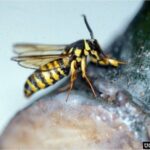Lilac-Ash Borer
Bark Beetles & Boring Insects
Lilac/Ash Borer (Podosesia syringae) is a type of insect pest that feeds on the bark and twigs of ash trees and lilacs. This species of borer is native to North America and primarily attacks ash trees, but can also infest lilac shrubs. The larvae of the lilac/ash borer burrow into the bark and tunnel through the sapwood of the tree or shrub, which can cause structural damage, weaken the plant, and reduce its ability to absorb water and nutrients.
In the early stages of infestation, the larvae feed on the inner bark, which can create a series of tunnels and galleries within the tree. Over time, these tunnels can lead to the death of the tree by interrupting the flow of water and nutrients. The presence of the lilac/ash borer is often detected by the presence of sawdust-like frass (insect excrement) around the base of the tree, or by the emergence of adult beetles from the bark.
Control measures for the lilac/ash borer include proper sanitation, avoiding injury to the bark of the tree, and using insecticides. Sanitation involves removing and destroying infested plant material, which can help reduce the population of the borer. Avoiding injury to the bark is important, as wounds or cracks in the bark can provide entry points for the borer to attack. Insecticides can also be used, but they are most effective when applied before the larvae have entered the bark of the tree or shrub.
In conclusion, the lilac/ash borer is a serious pest that can cause significant damage to ash trees and lilac shrubs. It is important to keep an eye out for signs of infestation and to take proactive measures to prevent or control outbreaks.




